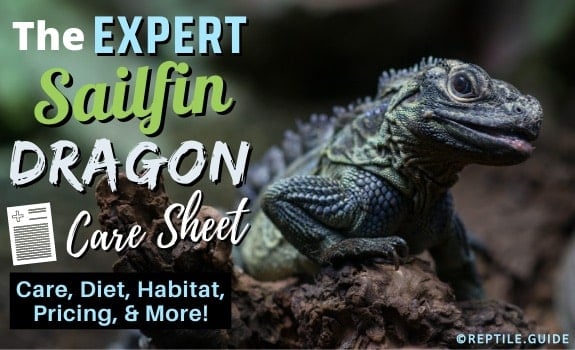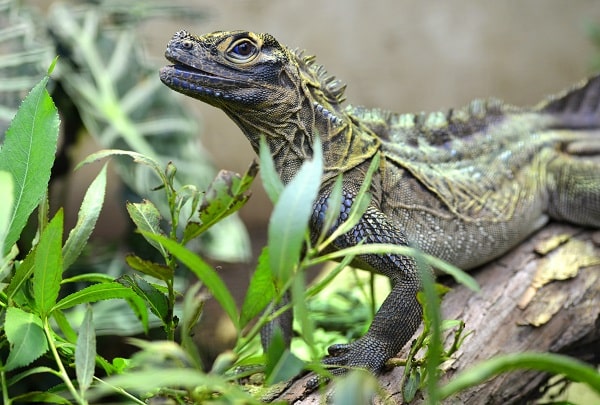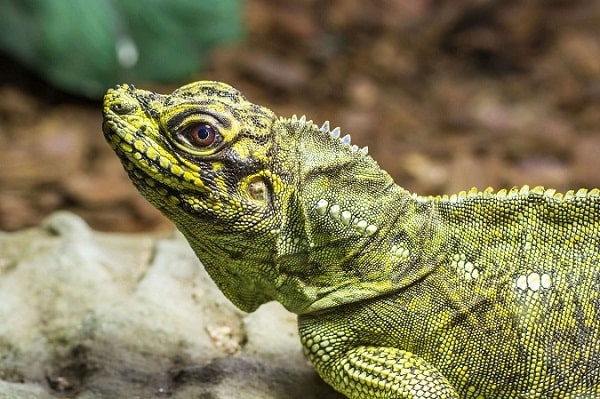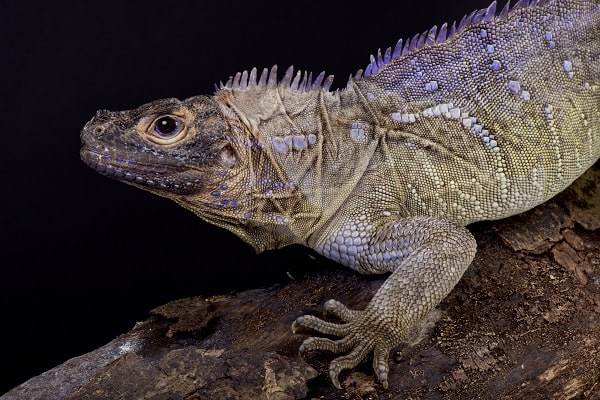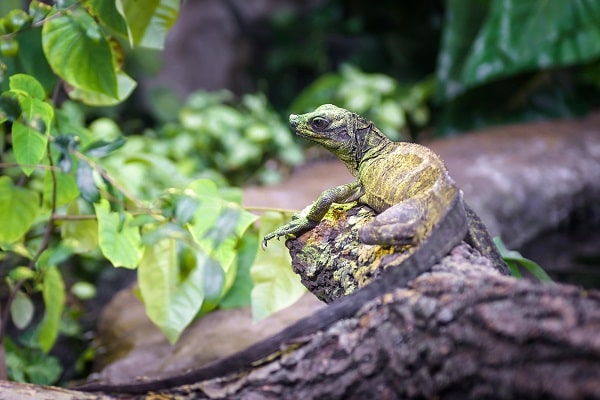While Sailfin Dragons aren’t popular enough to be on most reptile keepers’ radar, any lizard enthusiast that lays their eyes on the occasional viral photo is sure to put this species on their bucket list of animals they’d like to own.
In fact, one look for yourself, and it’s easy to see why.
These fantastic animals feature brilliant coloration, impressive size, and a magnificent crest that gives them major prehistoric, dragon, or Godzilla vibes.
Still, most part-time hobbyists simply don’t have the resources to give this animal what it requires to survive and thrive in captivity, so they remain the subject of dreams while still actually rare in the trade.
Furthermore, they’re quite difficult to breed, and it seems there is more of a focus on importing them rather than unlocking the secrets to producing them in captivity.
This is a shame because this one-of-a-kind species’ wild population is suffering due to collection for the pet trade.
It’s a good thing that these guys are so mesmerizing to look at, too, because their high-strung, flighty temperament makes them poor candidates for frequent handling.
If you’re still interested in the magical Sailfin dragon, keep reading to find out if you have what it takes to house and care for one!
In This Article
Sailfin Dragon Species Summary
The name “Sailfin Dragon” refers to at least five distinct species of agamids native to the Philippines, New Guinea, and Indonesia:
- Hydrosaurus amboinensis
- Hydrosaurus celebensis
- Hydrosaurus microlophus
- Hydrosaurus pustulatus
- Hydrosaurus weberi
The Philippine Sailfin Lizard, Hydrosaurus pustulatus, was regularly imported in the 1980s and the 1990s, but the country eventually banned their exportation to protect the species.
These days, the most common Sailfin Dragons in captivity are from Indonesia, home to Hydrosaurus microlophus and Hydrosaurus amboinensis.
For the most part, their appearance, size, and husbandry requirements are quite similar.
Sailfin Dragons are both semi-arboreal and semi-aquatic. They inhabit wetlands, riverbanks, and forests surrounding lakes.
They enjoy foraging for insects, fruits, flowers, leaves, and small animals, or basking amongst high tree branches where they can jump into nearby bodies of water if they sense danger.
In addition to their sail-like crest, they have flattened toes that allow them to skip across the water’s surface for short spurts.
Their tail’s unique anatomy makes them strong swimmers, and they can hold their breath and hide underwater for up to an hour.
Appearance & Colors
Each of the Sailfin Dragon species has a slightly different appearance.
In general, they are heavy-bodied lizards with long tails that resemble iguanas in body shape.
Their base color is usually brown or gray with green, blue, or purple spots. These spots gradually fade as the animal matures, creating a mostly patternless, dark brown lizard with areas of green, red, or purple hues.
They’re named after the large crests along their tail and lower back, which are more prominent in males.
They also have spikes and fleshy protrusions along the back of their neck and, in some species, their nostrils.
Sailfin Dragon Size
All four species of Hydrosaurus measure between 3 and 4.5 feet long in adulthood, with males being slightly larger than females.
Sailfin Dragons are the largest members of the agamid family of lizards, which include well-known reptiles like bearded dragons, Chinese water dragons, and uromastyx lizards.
Hatchlings are 10 to 15 inches in length and take 3 to 5 years to reach sexual maturity.
Lifespan
A Sailfin Dragon’s lifespan is hard to pin down because they haven’t been studied very well in the wild, and they entered the pet trade in the 1990s.
Some keepers have had their Sailfin Dragon for over 20 years, while others report their 14 and 15-year old dragons still occasionally reproduce.
Our best estimate on the lifespan of a healthy Sailfin Dragon is at least 25 years.
| Facts at a Glance: | |
|---|---|
| Common name | Sailfin Dragon |
| Scientific name | Hydrosaurus microlophus and Hydrosaurus amboinensis |
| Adult size | 36-54 inches |
| Price | $100 to $200 |
| Lifespan | 25 years |
| Diet | Omnivores |
| Tank Size | 5’ x 5’ x 6’ |
| Temperature & Humidity | Basking Spot Temperature: 110-120°F, Ambient Temperature: 80-90°F, Humidity: 75+% |
| Popular alternatives | Bearded dragons, Chinese water dragons, Uromastyx |
Sailfin Dragon Care Sheet
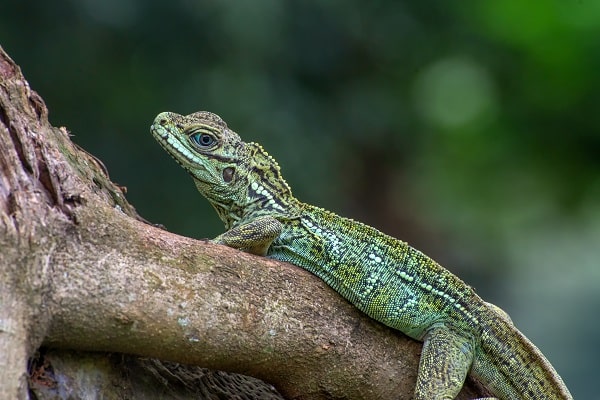
Some keepers say that their care requirements are similar to Chinese Water Dragon care. If you have any experience with other tropical reptile species, that will help you learn how to care for a Sailfin Dragon.
In addition to requiring tropical conditions, this is a rather large, active, and high-strung species, so they require a large, secure, and safe enclosure.
They can’t comfortably live in any pre-made, commercially available reptile habitats – you will need to build one yourself.
As far as diet goes, they are happy omnivores that can eat anything that’s considered healthy for an iguana, bearded dragon, or turtle.
Enclosure Size & Dimensions
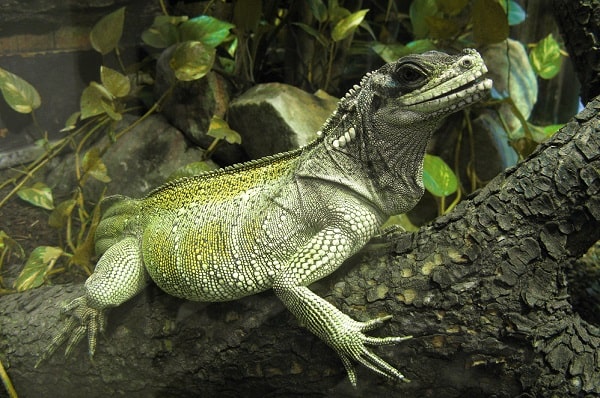
Minimum Adult Enclosure Dimensions: 5’ x 5’ x 6’
This species is considered semi-arboreal as well as semi-aquatic.
They bask in the trees, forage for food on the ground, and use water to escape predators and feel secure.
The larger you can make the enclosure, the better, as this is a relatively active species.
Be sure to add several feet to the enclosure’s length and width if you’ll be housing more than one animal.
Sailfin Dragons under 6 months old, or 20” long, can be housed in an enclosure that is 48” x 12” x 16”.
Habitat Setup
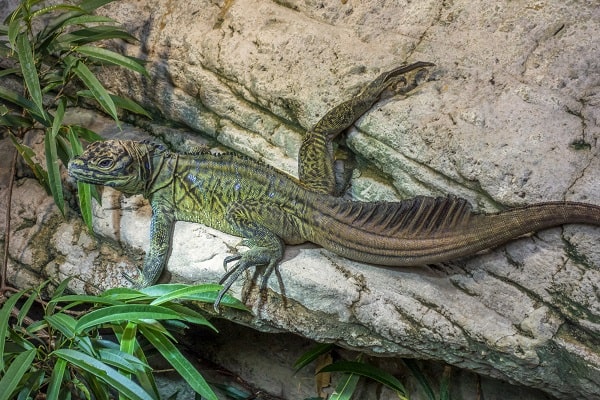
Offer your Sailfin Dragon a large, semi-arboreal set-up.
In the wild, they often bask high up in tree branches along waterway banks.
Use large branches, propped or mounted at various angles and heights to replicate their natural habitat in captivity.
The branches should be as wide as the widest part of your lizard’s body to minimize slips and falls.
Artificial or living plants, especially vines, will offer your Sailfin Dragon some much-appreciated cover and security, as well as increase the visual appeal of the habitat.
Most pet Sailfin Dragons also enjoy shelves at various heights.
You should include at least one large water dish that’s big enough for your lizard to fit inside of.
Your Sailfin Dragon will use this as a drinking water source as well as a toilet, so it will need to be cleaned daily.
You could also experiment with heavy-duty pool filter systems, which can also be used to create an attractive and enriching waterfall feature. This would also help to keep the humidity adequately high.
In addition to the water dish, you will need to keep a food dish and, if you’re keeping a female, a nesting box on the floor of the habitat.
The substrate should be able to hold moisture and resist mold growth.
Most Sailfin Dragon keepers use any of the following as substrate:
- Cypress mulch
- Coconut husk
- DIY mixture of organic topsoil and washed play sand
If you keep the substrate at least 6” deep, it will make a dramatically positive impact on the humidity level of the habitat.
To help your Sailfin Dragon feel safe, you should use an enclosure with solid sides or block clear sides with cardboard or black construction paper.
These lizards are flighty and cannot comprehend the nature of glass when they’re trying to escape from a perceived threat.
Temperature & Lighting
Sailfin Dragons require a hot basking spot and a high output UVB bulb unless they have access to natural sunlight.
Keep in mind that glass and many mesh screens block UVB, even if you house your Sailfin Dragon outside.
| Temperature & Lighting Summary | |
|---|---|
| Basking Spot Temperature: | 110-120°F |
| Ambient Temperature: | 80-90°F |
| Night-time Ambient Drop: | 70-80°F |
Since Sailfin Dragons require a tall, semi-arboreal enclosure, it may be ideal to have both overhead and bottom heat.
Be sure to follow manufacturer instructions and always use a thermostat to avoid fire hazards.
Suitable overhead heating options include:
- Incandescent light bulbs
- Carbon filament heat projectors
- Ceramic heat emitters
- Radiant heat panels
Suitable floor heating options include:
- Heating pads
- Heat mats
- Heat cable
- Heat rope
- Heat tape
Keep your reptile-specific UVB lighting on an electronic timer that’s set to turn off the lights after 12-14 hours.
Humidity
Ideal Humidity: 75%+
Aim to keep the humidity in your Sailfin Dragon’s enclosure as high as possible. Their native range and habitat have constant high humidity.
While the enclosure needs to be humid, please ensure that it is also well-ventilated and not “wet.”
Your Sailfin Dragon should be able to bask and dry its scales completely to prevent bacterial and fungal infections.
The easiest way to achieve this, especially for large adult habitats, is to construct a habitat from plastic or sealed wood and install a misting system.
If you’re using a glass aquarium with a screen lid for a younger animal, a sheet of plexiglass or insulation tape over the mesh is useful for preventing evaporation.
A deep, moisture-retaining substrate is also key to a tropical habitat.
Be sure to till it up whenever it looks compacted because airflow within the deep layers is key to increasing the ambient relative humidity.
Water
As much as this species loves water, not all Sailfin Dragons are capable of “figuring out” their water dish on their own.
Young animals under a year old should be directly misted at least twice per day.
It’s crucial to continue misting them directly at least once a day until you notice that they’re drinking straight from their water dish or until you see that they are no longer eagerly lapping up the water droplets you spray onto their face.
After your Sailfin Dragon achieves this milestone, you may install a habitat mister to make your life easier or simply focus on misting the enclosure once a day.
As far as the water dish, it should be large enough for your Sailfin Dragon to soak and submerge its body.
These large lizards love to swim, so if you can accommodate a larger water container, that would be ideal.
Most Sailfin Dragons defecate in their water dish.
On a positive note, this means that your lizard is more-or-less potty trained, and you won’t need to clean the enclosure or change the substrate as often.
Unfortunately, it also means the water will need to be changed and the dish disinfected daily.
Captive Sailfin Dragons also seem to enjoy weekly baths in lukewarm water. This gives you a chance to observe them engaging in totally enriching, natural swimming behaviors.
Food & Diet
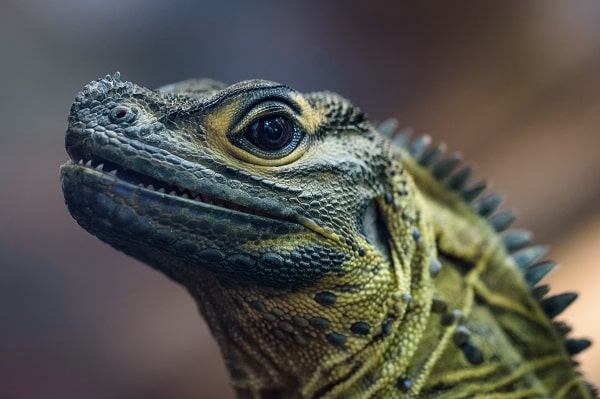
Surprisingly, this species hasn’t been studied very much, so it’s natural diet isn’t well-understood.
Most experienced keepers agree that Sailfin Dragons are omnivorous, requiring vegetables, fruits, and protein sources.
As with most species, growing youngsters require more protein in their diet than adults. Mature, egg-laying females need additional calcium supplementation.
As a loose guideline, aim to provide 75% protein and 25% plant matter to juvenile Sailfin Dragons. Adult Sailfin Dragons seem to do well on a diet that consists of 50% protein and 50% plant matter.
The plant matter portion of your lizard’s diet can be constructed similar to what you would offer to an iguana:
- 70% leafy greens
- 20% shredded or soft vegetables
- 10% fruits
Approved Food List
Here are leafy green, vegetable, fruit, and protein suggestions, with high-calcium foods prioritized at the top of each list.
Leafy Greens:
- Collard greens
- Turnip greens
- Mustard greens
- Dandelion greens
- Kale
- Watercress
- Swiss chard
- Spinach
- Leeks
- NO iceberg lettuce
Vegetables:
- Wax beans
- Turnips
- Okra
- Green beans
- Shredded carrot
- Summer squash
- Cooked sweet potato
Fruits:
- Papaya
- Berries
- Figs
- Mango
- Apple
Protein:
- Black soldier fly larvae
- Shrimp
- Crayfish
- Minnows
- Mice
- Bait crabs
- Roaches
- Cooked fish, chicken, and organ meat
- Other feeder insects
- Soaked dog kibble
Potential Health Issues
The most frequent health risks that captive Sailfin Dragons face are nose abrasions and other injuries that stem from attempting to escape a threat.
Sailfin Dragons do not understand the concept of glass, and they will continue to see it as an escape route if it’s not covered.
Covering every side of a glass enclosure can be extremely helpful in preventing these injuries.
You can leave a small viewing window if you wish, but leaving even one full side uncovered isn’t recommended, especially during acclimation.
Being arboreal, they’re also at risk for fall injuries if they get spooked off of branches or shelves. Sphagnum moss can be used to create soft landing areas under favored perches.
Since Sailfin Dragons are native to the tropics and inhabit environments bordering water bodies, stuck sheds are another common issue for captive animals.
Stuck sheds are caused by dehydration and low relative humidity in the habitat.
The leftover dead skin can result in the loss of toes, tail tips, and deformed crests.
Finally, imported animals are usually carrying internal parasites. Symptoms include bloody residue near the vent and diarrhea.
It’s always a good idea to take two fresh stool samples to your reptile veterinarian to test for intestinal parasites.
Behavior & Temperament
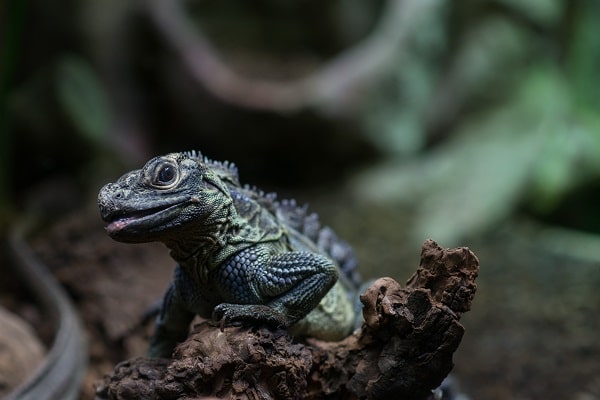
Sailfin Dragons are notoriously flighty and high-strung.
They’re incredibly wary of perceived threats, including you, your pets, and even their own reflection.
Wild Sailfin Dragons leap from tree branches into the water when they sense danger, where they hide for up to an hour before needing to surface for air.
They’re also known for running across the surface of the water, just like the infamous basilisk “Jesus Lizard.”
Wild-caught Sailfin Dragons may never become accustomed to your presence, and even captive-born babies can take up to six months before they trust you.
Sailfin Dragon Handling
It’s best to avoid handling any Sailfin Dragon for the first 4 to 6 months after bringing it home.
This gives it an ample amount of time to become used to you and its new surroundings.
Once you start handling, it’s essential to work slowly, on your animal’s terms, and consistently.
Start by placing your hand in your Sailfin Dragon’s enclosure for 5 minutes every day. You could also try tong feeding so that your lizard begins associating your scent and presence with food.
Allow your Sailfin Dragon to come to you, within reason.
Restraining your lizard after it’s been spooked can result in significant injury – to you and the lizard!
Large adults are capable of inflicting painful tail whips, scratches, and bites.
Do Sailfin Dragons Make Good Pets? A Summary
If you’ve fallen for this obscure species as most reptile enthusiasts do, we hope our species overview and husbandry guide helped you decide if a Sailfin Dragon would make a good addition to your household.
As long as you have the time required for…
- Misting and daily water changes
- Space and experience needed to build an adult enclosure
- General knowledge of caring for tropical reptile species
…you can probably feel confident taking on this lizard’s intermediate level of care.
Besides, who wouldn’t want to own their own miniature Godzilla?
